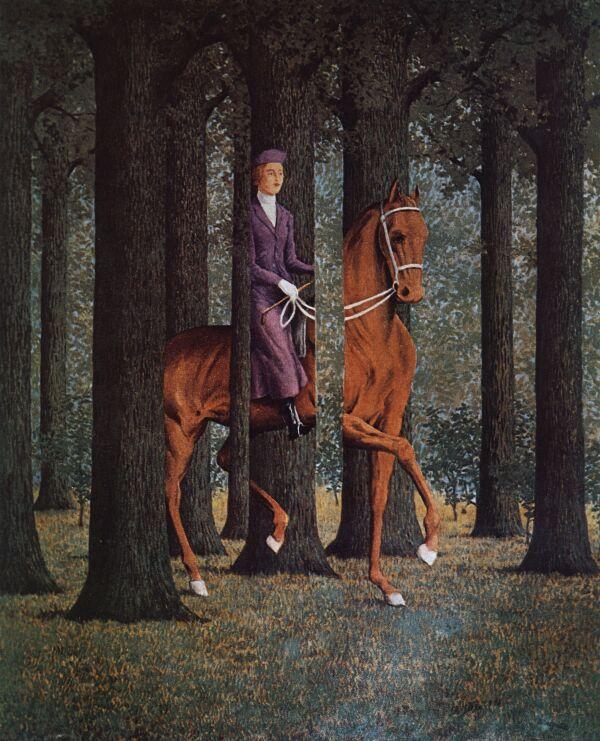Surrealism
With roots in Dada, surrealism entered the Paris scene in 1924, searching for the “more real than real world behind the real” – the world of institution, dreams, and the unconscious realm explored by Freud. André Breton was the founder of surrealism and imbued the word with all the magic and dreams, the spirit of rebellion, and the mysteries of the subconscious in his Manifesto du Surréalisme in 1924.
Tristan Tzara joined Breton, Paul Aluard and Louis Aragon in Zurich where he stirred the group on towards scandal and rebellion. These young poets rejected the rationalism and formal conventions dominating postwar creative activities in Paris.
They sought ways to make new truths, to reveal the language of the soul. Surrealism was not a style or a matter of aesthetic, but rather a way of thinking and knowing, a way of feeling, a way of life. Dada contrasts heavily with Surrealism, as Dada was negative, destructive and perpetually exhibitionist and surrealism professes a poetic faith in man and his spirit. Humanity could be liberated form social and moral conventions. Intuition and feeling could be freed. The writers experimented with stream-of-consciousness writing, or automatism, to seek an uninhibited truth.
The impact of the surrealist poets and writers has been limited to French literary and scholarly circles. It was through the movement’s painters that surrealism affected society and visual communications. While surrealists often created works so personal that communication became impossible. They also produced images whose emotional content, symbolism, or fantasy triggered a collective, universal response in large numbers of people.
Giorgio de Chirico, The Departure of the Poet, 1914.
De Chirico’s timeless poetry stops short of the bizarre or supernatural.
Giorgie de Chirio was declared the first realist painter. He painted hauntingly empty vistas of Italian Renaissance palaces and squares that possess an intense melancholy. Vacant buildings, harsh shadows, deep tilted perspective and enigmatic images convey emotions far removed from ordinary experience.
A restless German Dadaist, Max Ernst, used numerous techniques that have been adopted in graphic communications. He was fascinated by wood engraving and reinvented them by using collage techniques to create strange juxtapositions. These surreal collages have had a strong influence on illustration.
His frottage technique involved using rubbings to compose directly on paper. As he looked at his rubbings, his imagination invented images in them, similar to how one sees images in clouds. From there he developed his rubbings into beautiful pictures. His process of transferring images from printed matter to a drawing or painting was called Decalcomania.
This enabled him to incorporate a variety of images onto his work in unexpected ways. This technique has been used extensively in illustration, painting and printmaking.
Max Ernst, collage from Une Semaine de Bonté
(A Week of Kindness), 1934. Photomechanical printing
techniques obliterate cut edges, unifying the image.
French art historians dubbed figurative surrealist painters “naturalists of the imaginary.” Space, color, perspective and figures are rendered in careful naturalism, but the image is an unreal dreamscape.
René Magritte, a Belgium surrealist, used jolting and ambiguous scale changes, defied the laws of gravity and light, created unexpected juxtapositions and maintained a poetic dialogue between reality and illusion, truth and fiction.
René Magritte, The Blank Signature, 1965.
The surrealists defied our rational understanding of the world,
and their vocabulary of pictorial and symbolic innovations began
to seep into the mass media.
Salvador Dali was a theatrical Spanish painter who influenced graphic design in two ways:
* His deep perspectives inspired designers to bring vast depth to the flat, printed page.
* His naturalistic approach to simultaneity has been frequently imitated in posters and editorial images.
The Persistence of Memory by Salvador Dali, 1931.
Time is the theme here, from the melting watches to the decay implied by the
swarming ants. The monstrous fleshy creature draped across the
paintings center is an approximation of Dalí's own face in profile.
Another group of surrealist painters, who worked with a purely visual vocabulary, was dubbed the emblematics. Joan Miró and Jean Arp, two of these painters, used a style called Visual Automatism to create spontaneous expression of inner life.
Miró explored a process of metamorphosis through which he intuitively developed his motifs into cryptic, organic shapes and Arp explored chance and unplanned harmonies as early as 1916.
The biomorphic forms and open compositions of these artists were incorporated into product and graphic design. Surrealism’s impact on graphic design has been diverse and provided poetic example of the liberation of the human spirit. It pioneered new techniques and demonstrated how fantasy ad intuition could be expressed in visual terms. Unfortunately, the ideas and images of surrealism have been exploited and trivialized frequently in the mass media.




Comments
Post a Comment